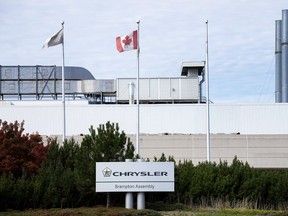World
Stellantis’ Shift Raises Questions on Canada’s EV Investment Strategy

Stellantis has announced a significant shift in its production strategy, moving the planned manufacturing of the Jeep Compass from Brampton, Ontario, to the United States. This decision jeopardizes approximately 3,000 Canadian jobs and raises broader questions about Canada’s ambitious investment in electric vehicles (EVs). The company plans to ramp up auto production in the U.S. by 50% over the next four years, focusing on states like Illinois, Ohio, Michigan, and Indiana, while shifting away from EV production.
The implications of Stellantis’ decision extend beyond immediate job losses. According to Kirsten Korosec, transportation editor at TC TechCrunch, this latest investment plan “doesn’t focus on electrification,” suggesting that EVs are taking a “backseat” in the company’s future plans. In response to the concerns expressed by federal and provincial leaders, including Prime Minister Mark Carney, Ontario Premier Doug Ford, and Brampton Mayor Patrick Brown, Stellantis has stated it remains committed to Canada. The company is currently in discussions with the government regarding future plans for the Brampton plant and a potential third shift at its Windsor facility.
This development raises critical questions about the wisdom of allocating up to $15 billion in federal and Ontario government subsidies to Stellantis and LG Energy Solution for the construction of an EV battery plant in Windsor. Additionally, more than $1 billion was previously announced to support Stellantis plants in Windsor and Brampton. The situation is compounded by the broader challenges facing the automotive industry, including tariffs imposed during the Trump administration aimed at relocating production to the U.S.
Automakers are grappling with declining EV sales, driven by consumer concerns over high prices, limited range, and the availability of public charging infrastructure. General Motors (GM) recently reported a $1.6 billion loss in its third-quarter EV earnings, attributing the downturn to a pivot away from EV subsidies and a renewed focus on gas-powered vehicle production.
As of April 2024, the Canadian federal government, along with the governments of Ontario and Quebec, has earmarked up to $52.5 billion to support 13 major EV projects across the country. This figure surpasses the $46.1 billion that the automotive sector planned to invest independently, according to the Parliamentary Budget Office.
In a related development, Honda has placed its $5 billion EV and battery plant projects in Ontario on hold for at least two years due to the slow sales of EVs in North America. Earlier this year, GM announced the closure of its Ingersoll assembly plant, which was producing the BrightDrop Zero EV delivery van, citing slow sales and plans to reopen at half capacity in November.
Further complicating matters, the federal and provincial governments had committed over $500 million to GM plants in Ingersoll and Oshawa in 2022. Additionally, a $300 million investment was announced in 2023 to support an EV battery component plant in Becancour, Quebec. However, the parent company of Northvolt Batteries North America filed for bankruptcy in Sweden in March, casting further doubt on the viability of planned investments in Quebec.
Despite these challenges, the structure of many government subsidies is linked to production guarantees, meaning that, thus far, relatively little taxpayer money has been disbursed. As the landscape of the automotive industry continues to shift, the future of EV production in Canada remains uncertain, with significant implications for jobs and investment across the country.
-

 World3 months ago
World3 months agoScientists Unearth Ancient Antarctic Ice to Unlock Climate Secrets
-

 Entertainment3 months ago
Entertainment3 months agoTrump and McCormick to Announce $70 Billion Energy Investments
-

 Science3 months ago
Science3 months agoFour Astronauts Return to Earth After International Space Station Mission
-

 Lifestyle3 months ago
Lifestyle3 months agoTransLink Launches Food Truck Program to Boost Revenue in Vancouver
-

 Technology2 months ago
Technology2 months agoApple Notes Enhances Functionality with Markdown Support in macOS 26
-

 Top Stories7 days ago
Top Stories7 days agoUrgent Update: Fatal Crash on Highway 99 Claims Life of Pitt Meadows Man
-

 Sports3 months ago
Sports3 months agoSearch Underway for Missing Hunter Amid Hokkaido Bear Emergency
-

 Politics2 months ago
Politics2 months agoUkrainian Tennis Star Elina Svitolina Faces Death Threats Online
-

 Technology3 months ago
Technology3 months agoFrosthaven Launches Early Access on July 31, 2025
-

 Politics3 months ago
Politics3 months agoCarney Engages First Nations Leaders at Development Law Summit
-

 Entertainment3 months ago
Entertainment3 months agoCalgary Theatre Troupe Revives Magic at Winnipeg Fringe Festival
-

 Politics1 week ago
Politics1 week agoShutdown Reflects Democratic Struggles Amid Economic Concerns


















